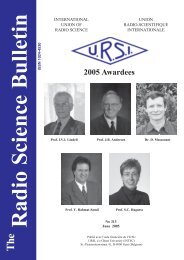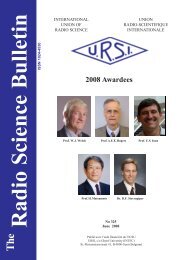December 2012 - URSI
December 2012 - URSI
December 2012 - URSI
Create successful ePaper yourself
Turn your PDF publications into a flip-book with our unique Google optimized e-Paper software.
c. All stations are encouraged to make f-plots on RWDs;<br />
f-plots should be made for high latitude stations, and for<br />
so-called “representative” stations at lower latitudes for<br />
all days (i.e., including RWDs and WGIs) (Continuous<br />
records of ionospheric parameters are acceptable in<br />
place of f-plots at temperate and low latitude stations);<br />
d. Copies of all ionogram scaled parameters, in digital<br />
form if possible, be sent to WDCs;<br />
e. Stations in the eclipse zone and its conjugate area<br />
should take continuous observations on solar eclipse<br />
days and special observations on adjacent days. See<br />
also recommendations under Airglow and Aurora<br />
Phenomena.<br />
For the 2013 incoherent scatter observation program,<br />
every effort should be made to obtain measurements at least<br />
on the Incoherent Scatter Coordinated Observation Days,<br />
and intensive series should be attempted whenever possible<br />
in WGIs, on Dark Moon Geophysical Days (DMGD) or<br />
the Airglow and Aurora Periods. The need for collateral VI<br />
observations with not more than quarter-hourly spacing at<br />
least during all observation periods is stressed.<br />
Special programs include:<br />
- Sudden Stratospheric Warming (StratWarm):<br />
Dynamics, electrodynamics, temperature and electron<br />
density in the lower and upper thermosphere and<br />
ionosphere during a sudden stratospheric warming event.<br />
Key objectives are: to extend studies of stratospheric<br />
warming effects to the lower and upper thermosphere and<br />
investigate coupling with the ionosphere, to document<br />
variations in multiple thermospheric and ionospheric<br />
parameters in response to different stratospheric sudden<br />
warming events, to capture and document ionospheric<br />
response to stratospheric sudden warmings during the<br />
rising solar activity, to measure electric field, neutral<br />
wind, electron and ion temperatures and electron density<br />
in the ionosphere and lower and upper thermosphere<br />
before and during sudden stratospheric warming, to<br />
compare variations in ionospheric and thermospheric<br />
parameters observed during SSW to average wintertime<br />
behavior of ionosphere and thermosphere, to compare<br />
variations in temperatures and winds to mesospheric<br />
response as given by MF and meteor radars and lidars,<br />
to examine mechanisms responsible for variations in<br />
lower and upper thermospheric dynamics, temperatures,<br />
electric field, and ionospheric electron density and<br />
investigate to what degree they can be related to sudden<br />
stratospheric warming<br />
Background condition: The observations need to be made<br />
before and during the sudden stratospheric warming. A<br />
10-day campaign is requested.<br />
Primary parameters to measure: LTCS mode - electron<br />
and ion temperatures from lowest possible altitudes<br />
throughout the F region, zonal and meridional<br />
components of the neutral wind in the lower<br />
thermosphere (95-140km), ExB drift, F-region<br />
meridional wind. Temporal resolution can be sacrificed<br />
and data integration period increased in order to obtain<br />
data at lower altitudes.<br />
Need for simultaneous data: The idea is to measure<br />
how variations in temperatures, electric field and winds<br />
associated with sudden stratospheric warming change<br />
with latitude and altitude and relate to variations in<br />
electron density.<br />
Principle investigator: Larisa P. Goncharenko, lpg@<br />
haystack.mit.edu, MIT Haystack Observatory, Westford,<br />
MA 01886, USA. Larisa is responsible for issuing the<br />
alert. She anticipates a few days’ notice.<br />
Co-investigators: Jorge Chau (Jicamarca Radio<br />
Observatory, Peru), Hanli Liu (NCAR, USA), Peter<br />
Hoffmann (Institute for Atmospheric Physics, Germany).<br />
- E-region E field: Latitudinal variation of the vertical<br />
electric field in the E region<br />
Key objectives: To measure the vertical and geomagnetic<br />
zonal ion drifts in the E and F regions, to study the<br />
height variation of the E-region electric field and its<br />
relationship to the F-region electric field<br />
Background Conditions: Ideally two days each during<br />
geomagnetically quiet and active periods.<br />
Primary Parameters to Measure: Vertical profiles<br />
of vertical ion drifts and geomagnetic zonal ion<br />
drift primarily during daytime. No beam swinging<br />
unless necessary to obtain the two components in the<br />
geomagnetic zonal plane. For single feed, swing in the<br />
geomagnetic zonal plane if possible.<br />
Secondary Parameters to Measure: Electron density,<br />
electron and ion temperatures.<br />
Principle Investigator: Qihou Zhou, zhouq@muohio.<br />
edu, Tel: +1-513-529-0743 Electrical and Computer<br />
Engineering Dept., Miami University, Oxford, OH<br />
45056, USA. Qihou will coordinate the observations<br />
and discuss with each ISR site to ensure that optimal<br />
modes will be used.<br />
- Synoptic: Experiments are intended to emphasize<br />
wide coverage of the F region, with some augmented<br />
coverage of the topside or E region to fill in areas of<br />
the data bases that have relatively little data<br />
Contacts: Jan Sojka, janjsojka@usu.edu; Mary<br />
McCready, mary.mccready@sri.com<br />
- AO -- Arecibo Observatory<br />
- JRO -- Jicamarca Radio Observatory.<br />
- Special programs: Mary McCready, Center for<br />
Geospace Studies, SRI International, 333 Ravenswood<br />
Avenue, Menlo Park, CA 94025, USA; tel:+1-650-859-<br />
5084; Fax:+1-650-322-2318; email: mary.mccready@<br />
sri.com, chair of <strong>URSI</strong> ISWG Commission G. See the<br />
2013 Incoherent Scatter Coordinated Observation Days<br />
(<strong>URSI</strong>-ISWG) webpage for complete 2013 definitions.<br />
- For the ionospheric drift or wind measurement by the<br />
various radio techniques, observations are recommended<br />
to be concentrated on the weeks including RWDs.<br />
- For travelling ionosphere disturbances, propose<br />
special periods for coordinated measurements of gravity<br />
waves induced by magnetospheric activity, probably on<br />
selected PRWDs and RWDs.<br />
- For the ionospheric absorption program half-hourly<br />
observations are made at least on all RWDs and<br />
44 The Radio Science Bulletin No 343 (<strong>December</strong> <strong>2012</strong>)
















